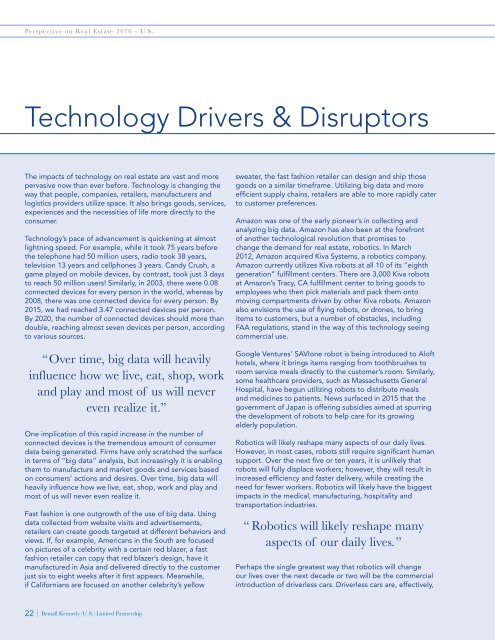BK Perspective Real Estate USA 2016
Create successful ePaper yourself
Turn your PDF publications into a flip-book with our unique Google optimized e-Paper software.
<strong>Perspective</strong> on <strong>Real</strong> <strong>Estate</strong> <strong>2016</strong> - U.S.<br />
Technology Drivers & Disruptors<br />
The impacts of technology on real estate are vast and more<br />
pervasive now than ever before. Technology is changing the<br />
way that people, companies, retailers, manufacturers and<br />
logistics providers utilize space. It also brings goods, services,<br />
experiences and the necessities of life more directly to the<br />
consumer.<br />
Technology’s pace of advancement is quickening at almost<br />
lightning speed. For example, while it took 75 years before<br />
the telephone had 50 million users, radio took 38 years,<br />
television 13 years and cellphones 3 years. Candy Crush, a<br />
game played on mobile devices, by contrast, took just 3 days<br />
to reach 50 million users! Similarly, in 2003, there were 0.08<br />
connected devices for every person in the world, whereas by<br />
2008, there was one connected device for every person. By<br />
2015, we had reached 3.47 connected devices per person.<br />
By 2020, the number of connected devices should more than<br />
double, reaching almost seven devices per person, according<br />
to various sources.<br />
“Over time, big data will heavily<br />
influence how we live, eat, shop, work<br />
and play and most of us will never<br />
even realize it.”<br />
One implication of this rapid increase in the number of<br />
connected devices is the tremendous amount of consumer<br />
data being generated. Firms have only scratched the surface<br />
in terms of “big data” analysis, but increasingly it is enabling<br />
them to manufacture and market goods and services based<br />
on consumers’ actions and desires. Over time, big data will<br />
heavily influence how we live, eat, shop, work and play and<br />
most of us will never even realize it.<br />
Fast fashion is one outgrowth of the use of big data. Using<br />
data collected from website visits and advertisements,<br />
retailers can create goods targeted at different behaviors and<br />
views. If, for example, Americans in the South are focused<br />
on pictures of a celebrity with a certain red blazer, a fast<br />
fashion retailer can copy that red blazer’s design, have it<br />
manufactured in Asia and delivered directly to the customer<br />
just six to eight weeks after it first appears. Meanwhile,<br />
if Californians are focused on another celebrity’s yellow<br />
sweater, the fast fashion retailer can design and ship those<br />
goods on a similar timeframe. Utilizing big data and more<br />
efficient supply chains, retailers are able to more rapidly cater<br />
to customer preferences.<br />
Amazon was one of the early pioneer’s in collecting and<br />
analyzing big data. Amazon has also been at the forefront<br />
of another technological revolution that promises to<br />
change the demand for real estate, robotics. In March<br />
2012, Amazon acquired Kiva Systems, a robotics company.<br />
Amazon currently utilizes Kiva robots at all 10 of its “eighth<br />
generation” fulfillment centers. There are 3,000 Kiva robots<br />
at Amazon’s Tracy, CA fulfillment center to bring goods to<br />
employees who then pick materials and pack them onto<br />
moving compartments driven by other Kiva robots. Amazon<br />
also envisions the use of flying robots, or drones, to bring<br />
items to customers, but a number of obstacles, including<br />
FAA regulations, stand in the way of this technology seeing<br />
commercial use.<br />
Google Ventures’ SAVIone robot is being introduced to Aloft<br />
hotels, where it brings items ranging from toothbrushes to<br />
room service meals directly to the customer’s room. Similarly,<br />
some healthcare providers, such as Massachusetts General<br />
Hospital, have begun utilizing robots to distribute meals<br />
and medicines to patients. News surfaced in 2015 that the<br />
government of Japan is offering subsidies aimed at spurring<br />
the development of robots to help care for its growing<br />
elderly population.<br />
Robotics will likely reshape many aspects of our daily lives.<br />
However, in most cases, robots still require significant human<br />
support. Over the next five or ten years, it is unlikely that<br />
robots will fully displace workers; however, they will result in<br />
increased efficiency and faster delivery, while creating the<br />
need for fewer workers. Robotics will likely have the biggest<br />
impacts in the medical, manufacturing, hospitality and<br />
transportation industries.<br />
“ Robotics will likely reshape many<br />
aspects of our daily lives.”<br />
Perhaps the single greatest way that robotics will change<br />
our lives over the next decade or two will be the commercial<br />
introduction of driverless cars. Driverless cars are, effectively,<br />
22 | Bentall Kennedy (U.S.) Limited Partnership


